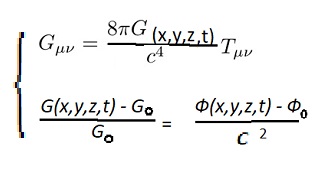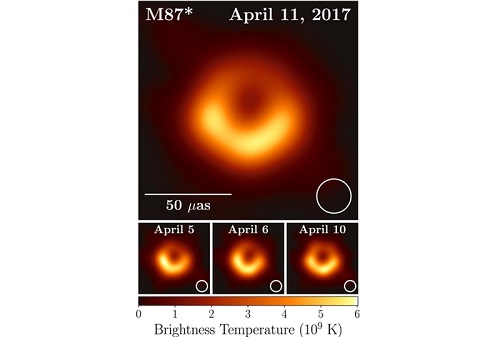At first glance, it may seem that the basic formula of V. Yanchilin's theory of gravity

contradicts the basic postulate of the theory of relativity about the constancy of the speed of light with=const
In fact, this is not the case, it's just that these theories work in different coordinate systems.
V. Yanchilin's theory of gravity, where the square of the speed of light is equal to the gravitational potential with a minus sign,
it works in the Galileo-Newton time space, in which the scale along the coordinate axes of space and time is unchanged,
and the theory of relativity works in Minkosky-Einstein space-time, which is bent by gravity, but so,
that the speed of light C remains constant. The curvature of space-time consists in changing the scale of the coordinate
the axes of space and time, but in such a way that the ratio of meter to second remains constant.
But there is a clear contradiction between these two theories. In Yanchilin's theory, black holes are impossible, but in Einstein's theory, they are.
Let's try to figure out which theory is wrong. Remember that black holes also appeared in Newton's theory of gravity.
If we approach a point body with mass M, then at some point the first cosmic velocity will equal the speed of light and,
then the light will not be able to leave the vicinity of this body. V. Yanchilin showed that the speed of light in Galileo-Newton space-time is not
constant and that when approaching the source of gravity, the speed of light increases in proportion to the square root of the gravitational
potential, which means that light can always leave the vicinity of the source of gravity, and hence that the existence of black < br />
holes are impossible.
And what then with the General Theory of Relativity, the constancy of the speed of light is its main postulate, there may be some other constant
is it actually a variable in it? Let's look closely at the Newton equation < / div>
and Einstein.

Both of these equations include the gravitational constant G as a constant. I assumed that in the Einstein equation G should be a variable,
as payment for fixing the speed of light.
But then the question arises, why should G change? There is a simple answer to this question, G is a dimensional constant, in the SI system its dimension is
m^3/kg*s^2. Its dimension includes a meter and a second, the curvature of space-time means a change in the meter and second, near a massive body they increase,
therefore, G must change according to the change in meter and second. Note that the speed of light C has the dimension m/s, and it is constant,
Hence, the ratio of meter to second in Einstein space is always constant. Then we write the dimension G in the following form (m/kg)*(m^2/s^2), < br /> kilogram
It does not depend on the curvature of space-time, hence it can be seen that G must change inversely proportional to the meter.
From 1927 to 1960, the standard meter was made as a platinum-iridium profile at ice melting temperature and atmospheric pressure, supported by two rollers,
which was stored in the city of Sevres near Paris.
Let's imagine the situation that an attacker entered this storage and sawed off the < br />
the standard of the meter is a piece "for memory", and for some reason it was not possible to restore the etalo. Then physicists would have to recalculate almost
all physical constants are based on the new standard of the meter.
Currently, in the SI system, the meter is defined as the length of the path traversed by light in a vacuum in (1/299,792,458) seconds,
and from 1960 to 1983, the meter was defined as 1,650,763. 73 wavelengths of the orange line (6056 Å) of the spectrum emitted by the krypton isotope 86Kr in vacuum.
The formula connecting the wavelength of the photon emitted by an atom and the gravitational potential is as follows

Therefore, the equations for the curvature of Einstein's spacetime should look, in the first approximation, something like this

Therefore, the equations for the curvature of Einstein's spacetime should look, in the first approximation, something like this. Thus, it turns out that as we approach a large mass, the gravitational constant G decreases. This means that
anti-gravity exists in nature, its source is gravity itself, it manifests itself in the fact that gravity limits
this means that black holes do not exist. This also means that there are no exceptions for the First zocon
Hegel's dialectic (Unity - the struggle of opposites ), it is also impossible to circumvent it, as it is impossible to circumvent the Law of Conservation of Energy and the Principle of
Heisenberg's Uncertainty.
The table below shows how the physical constants and units of measurement should change depending on the gravitational potential in the Galilean space-time and in the Einstein space-time
| |
Galileo Space-time< / td>
| Einstein Space-time< / td>
|
| second |
not change |
changes < /td>
|
< td>meter < /td>
| not change |
changes in proportion to the second |
| speed measurement unit m / s |
does not change |
not change |
| the unit of measurement for momentum kg*m.with< / td>
| does not change |
not change |
| unit of energy measurement, Joule |
not change |
not change |
| unit of angular momentum, joule*s |
not change |
changes in direct proportion to the change in the second |
| speed of light |
changes in direct proportion to the square root of the gravitational potential |
does not change |
| gravitational constant |
not change |
varies inversely with the change in meter or second |
| electrical constant |
not change |
changes in direct proportion to the change in meter or second |
| magnetic constant |
changes inversely proportional to the gravitational potential |
changes in direct proportion to the change in meter or second |
| Planck's constant |
changes inversely to the square root of the gravitational potential |
varies inversely with the change in meter or second |
| characteristic impedance of vacuum |
изменяется обратно пропорционально квадратному корню из гравитационного потенциала |
изменяется обратно пропорционально изменению метра или секунды |
| elementary electric charge |
not change |
not change |
| fine structure constant |
not change |
not change |
| the ratio of the Coulomb force of repulsion of two electrons to the force of their gravitational attraction |
not change |
not change |
But whether the observation data contradicts the statement that black holes do not exist, what is the object in these photos?

And this is just a supermassive body, leaving the gravity of which the light experiences a very large red shift, which leaves
in the invisible long-wave part of the spectrum, maybe even in the region of ultra-long radio waves. This is not a true black hole, but a psedvdochernaya
a hole or a quasi-black hole, it does not and cannot have an event horizon.
It should also be said that a change in the gravitational potential of the Universe should lead to a change in the gravitational constant.
There are serious objections to this. "Let's ask the question: what should have changed in the last 10 ^ 9 years
(the time of the appearance of life on Earth), i.e. beyond the Vio age of the universe? During this time, the gravitational constant would increase by 10%.
It turns out that if we consider the structure of the Sun — the balance between its mass and the degree of generation of radiative energy inside the Sun-then at
with a 10% increase in gravity, the Sun would not be 10% brighter, but much larger: its brightness would increase as the sixth degree of constant gravity!
You can also calculate how much this change in gravity will bring the Earth closer to the Sun. As a result, it turns out that the Earth would become more
more than 100° hotter and, consequently, all the water from the seas would turn into steam. Therefore, we now do not believe that the constant of gravity changes
as the world ages. " (End quote, Feynman Lectures on Physics, Volume 1, Chapter 7). But it can be answered like this, along with the gravitational
the electrical constant will also change synchronously. Its dimension is Farad/Meter or Pendant/Volt * meter, so it will be
change inversely proportional to the gravitational constant. But if in the Law of Universal Gravitation the Gravitational constant is in
in the numerator, then the electric constant is in the denominator. Thus, when the gravitational potential changes, the force ratio
the electric repulsion of two protons to the force of their gravitational attraction will remain unchanged, hence the thermonuclear conditions
the stars in the stars will not change. In addition, changing the gravitational constant will change the distance from the planet to the star
and, it seems that this should change the amount of energy that the planet receives from the star, but the radius of the polanet will also change
and its cross-section. Thus, the ratio of the cross-section of the planet to the radius of the sphere in which the planet's orbit is inscribed,
it will remain unchanged. Thus, the amount of energy received by the planet from the star will also remain unchanged.